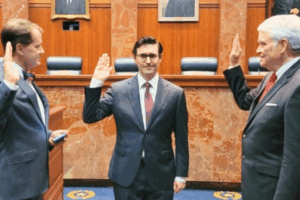AUSTIN, Texas — More than 3 out of 4 Americans (76 percent) now believe that climate change is occurring, up from 68 percent just one year ago, according to the latest University of Texas at Austin Energy Poll.
The biannual nationwide survey, conducted Sept. 1–15, also reveals growing support for environmental protection in several areas, especially among Democrats and millennials.

The poll, now in its fifth year, reveals sharp political divisions among Americans on several prominent energy issues. For example, 90 percent of Democrats say climate change is occurring, compared with 59 percent of Republicans (up from 47 percent six months ago); 29 percent of Republicans say climate change is not occurring, compared with only 3 percent of Democrats.
“Political ideology continues to be the single greatest determinant of Americans’ views on climate change,” said UT Energy Poll Director Sheril Kirshenbaum.
“Party affiliation also colors perceptions of other controversial energy topics,” she added, “including efforts to reduce coal-fired power and levy a tax on carbon.”
Energy also appears to be an important issue in the upcoming presidential election. For example, 52 percent of survey respondents say they are more likely to vote for a candidate who supports reducing coal as an energy source, up from 43 percent in March.
- Sixty-two percent of Democrats support the policy, compared with 40 percent of Republicans; 65 percent of respondents age 35 and younger support reducing coal use, compared with 42 percent age 65 and older.
Thirty-seven percent of survey respondents say they are more likely to vote for a candidate who favors imposition of a carbon tax, up from 28 percent six months ago.
- Fifty percent of Democrats support a tax on carbon, compared with 26 percent of Republicans; 54 percent of millennials support a carbon tax, compared with 27 percent of Americans age 65 or older.
Sixty-two percent of Americans say they are more likely to vote for a candidate who supports requiring utilities to obtain a certain percentage of their electricity from renewable sources, up from 54 percent six months ago.
- Nearly 3 out of 4 Democrats (74 percent) support such a requirement, compared with 50 percent of Republicans.
Other findings from the UT Energy Poll include:
Gasoline prices. Today, 58 percent of respondents describe gasoline prices as high, compared with 66 percent in March and 92 percent a year ago. And, 62 percent expect gasoline prices to increase six months from now, compared with 84 percent in March and 76 percent a year ago.
Fracking. Nearly half of respondents (48 percent) are familiar with hydraulic fracturing, or fracking, compared with 44 percent a year ago. Among those familiar, 43 percent support fracking and 41 oppose it; a year ago, 44 percent supported the practice and 41 percent opposed it.
Fifty-eight percent of respondents familiar with fracking continue to say cities should be able to ban it within their borders even if state law otherwise permits it. Today, 18 percent oppose granting cities such local authority, compared with 25 percent six months ago.
Export of natural gas. The percentage of Americans who favor policies allowing the export of U.S. natural gas has increased, from 34 percent a year ago to 38 percent today, while opposition to the export of domestic gas has declined from 28 percent six months ago to 23 percent today.
For more, review several charts highlighting views of key energy issues and poll methodology.
The UT Energy Poll was launched in October 2011 to provide an objective, authoritative look at consumer attitudes and perspectives on key energy issues. The survey is designed to help inform national discussion, business planning and policy development. The ninth iteration of the UT Energy Poll was conducted online Sept. 1–15, 2015, among 2,019 U.S. residents age 18 and older. Figures for age, sex, race/ethnicity, education, region and household income were weighted where necessary to bring them into line with their actual proportions in the population. A propensity score weighting approach was also used to adjust for respondents’ propensity to answer online surveys. With a sample size of 2,019 and weighting efficiency of 50.3 percent, the overall margin of error is 3.1 percentage points at the widest interval.



